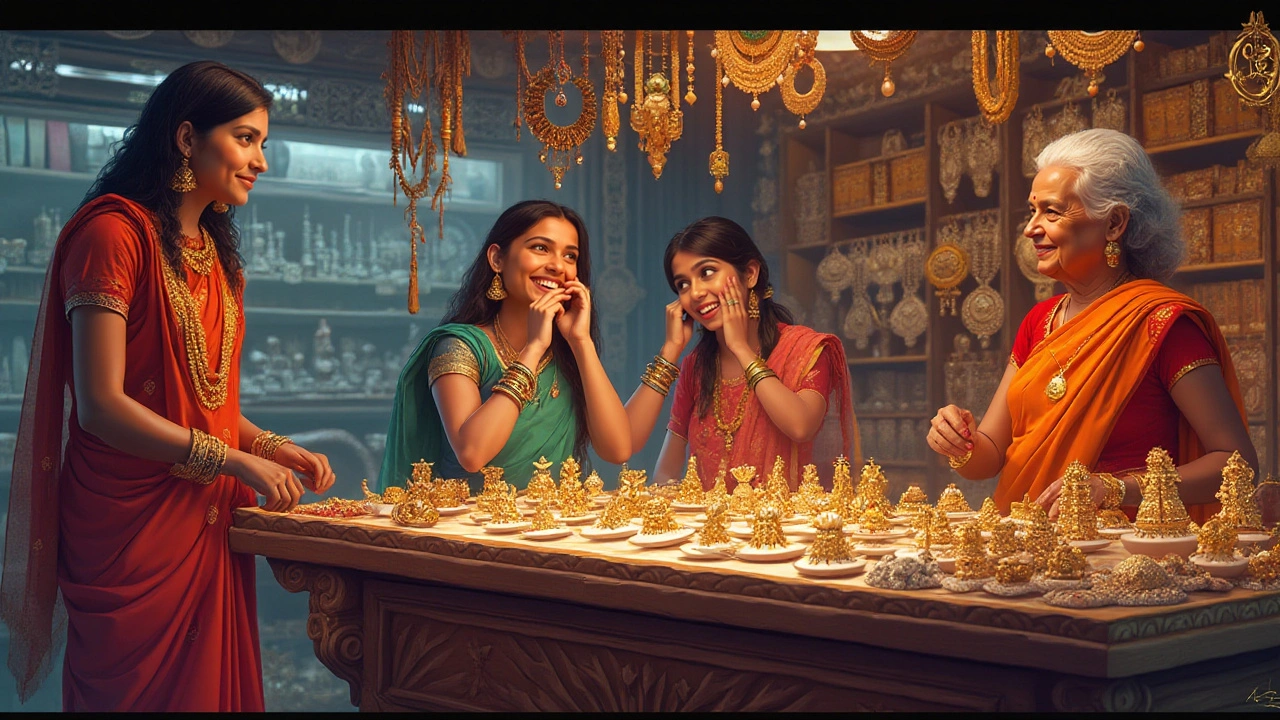
Nose pins, once a mere cultural adornment, have surged into the global fashion spotlight as a statement accessory. Their origins trace back to ancient cultures, where they often held symbolic meanings and played significant roles in traditional attire.
These days, the versatility and variety available in nose pin designs allow for personal expression that transcends boundaries, embracing both style and cultural identity. Selecting the right spot for a nose pin is more than just a personal preference. It involves considering facial features, comfort, and even the interplay of traditional and contemporary styles.
As we dive in, let us journey through the fascinating world of nose pins, exploring the best positions, popular designs, and the ever-evolving trends that keep this accessory timeless yet refreshingly unique.
- Historical Significance
- Different Nose Pin Positions
- Cultural Influences
- Choosing the Right Nose Pin
- Care and Comfort
- Contemporary Trends and Innovations
Historical Significance
Exploring the historical journey of nose pins unveils a rich tapestry of cultural nuances and traditions that have been cherished over centuries. These small yet influential pieces of jewelry have adorned faces in various corners of the world, leaving a mark on generations. Originating from South Asia, the nose pin, often referred to as 'nath' in India, bears significant cultural weight. It's not merely decorative; it signifies marital status and is an integral part of bridal attire in numerous communities. This tradition finds its roots in the practice of Ayurvedic medicine, where practitioners believed that piercing the nostril alleviated pain during menstruation and childbirth. Such metamorphoses in significance demonstrate the deep-seated place of nose pins in human civilization.
During ancient civilizations, retaining their charm, nose pins found their way into the Middle Eastern and African cultures. Tribes in Africa embraced nose pins not only as ornaments but as status symbols, indicating wealth and social standing. In some communities, the size of the nose ring signaled the affluence of the wearer, and it was often gifted by the groom to the bride during engagements. This tradition continues to resurface in some cultures today, proving the timeless appeal of such tiny yet influential adornments.
Nose pins are not just a contemporary trend; they are an unbroken thread that ties modern fashion to ancient traditions, reasserts Sophia Wood, an expert in cultural anthropology.Europe's encounter with the nose pin traces back to the late sixteenth century when explorers brought back these intricate pieces from their travels in Asia. However, it wasn't until the bohemian movements of the 1960s and 70s that nose pins truly gained traction in Western fashion, along with a sense of rebellion and self-expression. This shift marked a pivotal moment where nose pins transitioned from cultural identifiers to statements of individuality and style.
The prevalent use of nose pins is seen not just in personal adornment but as pivotal components in art and sculpture from various eras. Across different timelines and cultures, nose pins have played roles that extend far beyond their aesthetic appeal, making them enduring minor marvels of the jewelry world. In examining their history, we uncover a story of shared traditions and evolving significance, where each turn and twist adds to their entrenched place in both cultural history and contemporary allure.
Different Nose Pin Positions
The world of nose pins is both diverse and fascinating, reflecting an array of cultural, aesthetic, and personal preferences. Nose pin placement significantly impacts not only the appearance of the individual wearing it but also the style statement it makes. Traditionally, the left nostril is the most common placement for a nose pin, particularly in Indian culture, where it is believed to relate to easing childbirth and menstrual pain due to its connection with the female reproductive organs. This belief is deeply rooted in Ayurvedic medicine, and many women continue to follow this custom.
On the other hand, wearing a nose pin on the right nostril has become more of a Western trend, allowing individuals to create a unique statement. While right nostril piercings do not carry the traditional meanings associated with the left side, they can be a subtle nod to nonconformity. It is worth noting that double nostril piercings, where both sides of the nose are adorned, have gained popularity in recent years, offering a symmetrical and balanced look. These options highlight the versatility available when selecting the best nose pin position.
"Nose piercings have evolved to become a form of self-expression, transcending cultural boundaries." - Rina Bhansali, Jewelry Historian
Another intriguing choice is the septum piercing, where the nose pin is placed in the cartilage between the nostrils. This position, often considered edgy and bold, has been embraced by both the punk subculture and high fashion circles alike. With roots in ancient warrior cultures around the world, septum piercings offer a fierce individuality. Smaller nose screws or cuffs in a septum piercing can provide a more discreet and refined look than the traditional heavy jewelry seen in historical contexts, making it practical for everyday wear. Engineering advancements have enabled this style to evolve, with magnetics offering temporary placements without the commitment of a piercing.
In addition, high nostril piercings present an option for those seeking subtlety. Positioned on the upper part of the nose bridge, these piercings require a steady hand and professional expertise due to the sensitive nature of the area. The placement allows for petite studs or pins to be used, creating an understated elegance. This less common piercing location often garners interest and intrigue, drawing attention to the wearer's sense of style without overshadowing other facial features. High nostrils, with their coveted minimalist appeal, have found their way into avant-garde fashion shows, highlighting how high positions can remarkably complement various face shapes and sizes.
Ring-style adornments, such as hoops and septum rings, have their own positioning considerations. The diameter and gauge of the ring should align with the nose's contour for both aesthetic value and comfort. The placement of a hoop can create contrasting effects depending on whether it hugs the nose closely or dangles with a gap. Customizable options for colors and materials such as gold, silver, titanium, or even enamel highlight the adaptability of nose pin fashion across different lifestyles and preferences. Mentioning the influence of celebrities who popularize specific nose pin styles, bringing them into mainstream appeal, is also worthwhile.
As fashion trends continue to change, the vast array of nose pin positions available ensures there is something for everyone. Each position, whether steeped in tradition or driven by modern innovation, allows individuals to showcase their personality and heritage. Whether considering a simple left nostril pin for understated beauty or a bold septum ring for a distinctive edge, the choice is endlessly personal, merging tradition with contemporary style in unique ways.
Cultural Influences
Cultural roots of nose pins hold a mesmerizing tapestry woven through centuries across various civilizations. In South Asia, particularly in India, nose pins or nose rings have been a fundamental part of women's adornment and are often associated with complex traditions. Historically believed to be of Persian origin, they were introduced to the Indian subcontinent in the 16th Century by the Mughals. Nose pins have since become ingrained in the cultural fabric of Indian society, often symbolizing marital status and beauty.
Much like Indian traditions, nose pins hold significant roles in Middle Eastern and North African cultures. Here, they serve as symbols of family wealth and status. Bedouin women have been known to wear intricate nose studs or rings, showcasing their status within their community. Even in modern times, these cultural traditions persist, echoing through generations as younger demographics adapt these symbols to contemporary styles while holding onto their cultural roots. Bosnian and Moroccan heritage also celebrates nose pins as manifestations of cultural identity and personal beauty.
The global fascination with nose pins can be noted in the words of historian Emma Tarlo: "Jewelry in various forms, including nose pins, speak silent stories of rich heritage, belief systems, and the delicate balance between ancient tradition and modern transcendence."
Heading across the globe, in Native American cultures, nose ornaments were emblematic of spiritual beliefs and tribal distinctions. Tribes such as the Nez Perce were named due to their prominent nose piercings, signifying either rites of passage or status symbols. In contrast, certain African cultures, like the Berber community, viewed these pieces of jewelry as protective amulets against curses and bad spirits.
Given these diverse cultural narratives, nose pins have been subjects of reinterpretation with the changing tides of globalization. In the west, especially during recent decades, state-of-the-art jewelry designs see nose pins as elements of bohemian or edgy fashion statements. Today's designers often draw inspiration from these historic influences to craft unique pieces that resonate with a global audience, by blending tradition with trailblazing designs. As a result, the story of nose pins shows us how fashion not only celebrates cultural legacies but also stands as a testament to our collective journey through time.

Choosing the Right Nose Pin
When it comes to selecting the perfect nose pin, it's not just about following the latest fashion trends; it's about finding a piece that truly complements your features and reflects your personal style. The journey to picking the right nose pin begins with understanding your facial structure. Those with more defined cheekbones might opt for a classic stud, which subtly highlights the complexion without overwhelming it. On the other hand, if you have a rounder face, an elongated design can provide a striking contrast, elongating the appearance naturally and elegantly.
Now, imagine walking through a vibrant market, the sounds of bustling traders all around, and before you, a stunning array of dainty designs glimmer under the sun. There is something for every taste, from minimalist studs to intricate hoops. Each piece tells its own story, shaped by the hands of skilled artisans. But how do you decide? Personal comfort should never be underestimated when making such a choice. Consider the daily wear of a nose pin. A small, delicate piece often feels much less intrusive, while a heavier, more elaborate design might require a period of adaptation.
Gold, silver, platinum—the material of your nose pin could determine not only the style but also longevity. Gold has a timeless quality, while silver, with its cool sheen, embodies a contemporary twist. Platinum nose pins are both rare and majestic, capturing light in a uniquely captivating way. And, in the realm of gemstones, traditional choices such as diamonds hold perpetual allure, as do more modern selections like colorful turquoise or mystic opals.
“Jewelry is a very personal thing... it should tell a story about the person who's wearing it.” — Garance Doré
Furthermore, if culture plays a role in your decision-making, you might find inspiration in traditional styles. In India, for instance, nose pins are often worn in celebration of cultural events and are known as 'Nath.' Meanwhile, Middle Eastern designs sometimes feature chains connecting the pin to the ear, creating a truly ornamental effect that bridges traditional and Avant-garde styles. Keep in mind that your chosen design should align with your lifestyle. Consider factors like workplace appropriateness and the practicality of your intended daily activities.
The last point to ponder is the type of piercing used. The traditional nostril piercing is the most widely recognized and adaptable; however, septum and bridge piercings have gained popularity for those seeking an edgier look. It's essential to ensure that the selected nose pin style is suitably comfortable for the type of piercing you've chosen to prevent any unnecessary irritation or discomfort.
Perhaps in sifting through this world of choices, you'll find a piece that resonates with you, much like selecting an artwork. Your reflection will not just mirror the face but the brilliant fusion of style, tradition, and personal nuance.
Care and Comfort
Embracing the art of wearing nose pins begins with understanding the paramount importance of care and comfort. The decision to adorn a nose pin is more than just a sartorial choice; it involves looking after one's skin and ensuring ease in daily wear. A well-maintained nose pin not only gleams with brilliance but also enhances your facial allure without causing discomfort. Potential wearers should first consult with a professional piercer. They provide insights into best practices, discuss potential allergic reactions to certain metals, and recommend aftercare solutions tailored to individual needs.
One of the primary concerns with any piercing is infection. The nose, sensitive and exposed, requires meticulous care post-piercing. A clean routine with saline solutions is often recommended, keeping the area free from bacteria, thereby minimizing the risk of infection. For those who notice any unusual swelling or prolonged discomfort, it's crucial to seek professional advice immediately. This isn't just about avoiding infections but ensuring that the jewelry styles you cherish continue to complement your beauty consistently.
According to Dr. Jane Hollister, a renowned dermatologist, "Nose pins, like any skin-affixed accessory, require diligence in care. The right metal choice can make a significant difference in comfort."Comfort is as vital as aesthetics. The weight and size of a nose pin should match your daily activity level. Those leading active lifestyles might prefer smaller, more secure designs, ensuring they stay in place through various undertakings. Meanwhile, those less active can explore more extravagant styles without concern for displacement.
Modern times have seen innovations in design and material that enhance wearer comfort. Hypoallergenic options, titanium bases, and durable designs ensure that every person can find something that suits both their skin type and style preference. Consideration extends to storage. When not in use, keeping your nose pins in a dry, clean setting guards against tarnishing and reduces the risk of unwanted skin reactions when next adorned.
Contemporary Trends and Innovations
In the dynamic world of fashion, nose pins have managed to blend tradition with modernity, and the latest trends are nothing short of revolutionary. Gone are the days when nose pins were simple studs or hoops; today, they have morphed into miniature sculptures and elaborate designs that cater to the tastes of a global audience. One of the standout trends is the play with materials. Designers are experimenting with everything from precious metals like gold and platinum to unconventional materials like resin, wood, and even sustainable materials. This shift not only caters to aesthetic preferences but also embraces the growing demand for eco-friendly and ethically sourced products.
Customization stands at the forefront of modern nose pin innovations. Many are opting for bespoke creations that reflect their personal stories or heritage. Jewellers are often approached to incorporate birthstones or motifs that hold sentimental value in their designs, a trend that resonates deeply in today’s personalized fashion landscape. The surge in digital tools has significantly aided this move towards customization, allowing customers to visualize their unique designs before commissioning them.
Influence of Global Cultures
The fusion of cultural influences has also shaped contemporary nose pin trends. In recent years, the bohemian aesthetic, characterized by intricate patterns and earthy tones, has gained widespread appeal. Additionally, minimalism has found a foothold within the nose pin culture, ushering in designs that are sleek, understated, yet striking. For those who prefer a futuristic flair, tech-infused innovations such as glow-in-the-dark elements or pins embedded with tiny LEDs are making waves, particularly among the younger demographic.Nostalgic pieces reimagined from vintage collections provide a continuous thread to the past while presenting a modern twist, making them "a bridge between eras," as noted by prominent jewelry historian Lydia Vasquez.
Technological advancements are not limited to design alone but also extend to how these pieces are crafted and retailed. The integration of augmented reality (AR) has introduced a 'try before you buy' experience, enabling consumers to visualize how a particular nose pin might look on them without stepping into a store. This technology is empowering shoppers to make confident decisions by offering a virtual fitting room experience right on their smartphones or tablets.
Piercing options have diversified alongside these innovations. Previously, the nose was predominantly pierced in the nostril crease, but now trendsetters are exploring septum piercings, high nostril positions, and dual piercings, all of which open up a myriad of styling possibilities. As these styles gather momentum, they present the perfect opportunity for individuals to experiment with multiple nose pins in varied arrangements.
Bold and Bright Future
The bold use of color is another defining characteristic of contemporary nose pin designs. Colored gemstones, enamels, and painted finishes provide an avenue for personalization that complements various skin tones and personal styles. As a celebration of diversity, these trends reflect a broader societal shift towards accepting and celebrating individual differences. The future of nose pins lies in this intersection of tradition and innovation, demonstrating that in fashion, there truly are no boundaries.
| Year | Trend |
|---|---|
| 2023 | Minimalist Designs |
| 2024 | Fusion of Cultural Styles |
| 2025 | Tech-Infused Jewelry |


